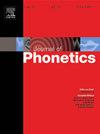Velar palatalization, phonologization, and sound change – A comparative acoustic study of /k/-fronting in Majorcan Catalan
IF 2.4
1区 文学
0 LANGUAGE & LINGUISTICS
引用次数: 0
Abstract
This study explores the acoustics of velar palatalization in two subvarieties of Majorcan Catalan, Manacor (palatalizing) and Artà (nonpalatalizing). Three production studies are reported: i) a study of /k/-fronting in the context of front, central, and back vowels; ii) a study of /a/-fronting in the context of /k/ and /p/; and iii) a study of /k/-fronting in various vowel contexts in the participants’ L2, Spanish. First, while we captured /k/-fronting in the progression /o/ > /a ə/ > /i/ in both subvarieties, effect sizes were much larger in Manacor than in Artà. There were no group differences in the acoustics of /k/ in the context of the back vowel, but there were large differences in the other vowel contexts, particularly before the central vowels. We postulate that, whereas the degree of palatalization found in Artà may result from universal coarticulatory principles, palatalization in Manacor results from speaker-controlled phonetic behavior: enhanced coarticulation. Second, we found that in Manacor (but not Artà) /a/ was more fronted when it followed /k/ that when it followed /p/. We suggest that the /a/-fronting pattern found in Manacor results from the influence of its velar-palatalization process and not vice versa. Finally, we found that the enhanced velar-palatalization process in the Manacor sample was not transferred to their L2. We discuss the implications of our conclusion for our understanding of the diachrony of velar palatalization in Romance.
马略坎加泰罗尼亚语/k/前音的比较声学研究
本研究探讨了马略坎加泰罗尼亚语的两个亚种,马纳科尔(舌化)和阿尔托孔(非舌化)的舌化声学。报告了三个生产研究:i)在前、中、后元音语境中/k/-fronting的研究;Ii)在/k/和/p/上下文中对/a/-前置的研究;iii)研究参与者在西班牙语第二语言中不同元音语境中/k/的前置。首先,当我们捕捉到/k/-在/o/ >;/a æ / >;/i/在这两个亚品种中,马纳科尔的效应量远大于阿尔托姆。在后面元音/k/的发音上下文中,没有组间差异,但在其他元音上下文中,特别是在中心元音之前,有很大的差异。我们假设,尽管在art中发现的舌化程度可能是由普遍的协同发音原则造成的,但在Manacor中发现的舌化是由说话人控制的语音行为造成的:增强的协同发音。其次,我们发现在Manacor(而不是art)中,/a/跟在/k/后面比跟在/p/后面更靠前。我们认为在Manacor发现的/a/-前缘模式是由于其腭腭化过程的影响,而不是相反。最后,我们发现Manacor样品中增强的腭腭化过程并没有转移到L2。我们讨论了我们的结论对我们理解《浪漫》中腭腭化的历时性的意义。
本文章由计算机程序翻译,如有差异,请以英文原文为准。
求助全文
约1分钟内获得全文
求助全文
来源期刊

Journal of Phonetics
Multiple-
CiteScore
3.50
自引率
26.30%
发文量
49
期刊介绍:
The Journal of Phonetics publishes papers of an experimental or theoretical nature that deal with phonetic aspects of language and linguistic communication processes. Papers dealing with technological and/or pathological topics, or papers of an interdisciplinary nature are also suitable, provided that linguistic-phonetic principles underlie the work reported. Regular articles, review articles, and letters to the editor are published. Themed issues are also published, devoted entirely to a specific subject of interest within the field of phonetics.
 求助内容:
求助内容: 应助结果提醒方式:
应助结果提醒方式:


